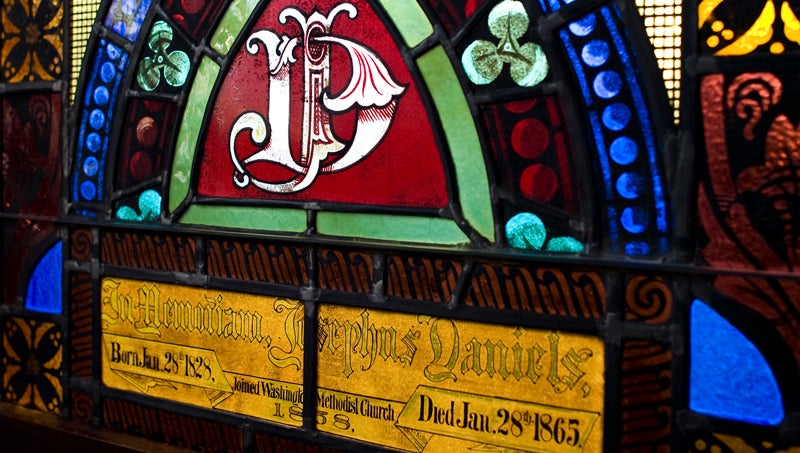Taking a tour through historic downtown Washington
Published 5:26 pm Thursday, July 7, 2016

- ETHEREAL BEAUTY: This stained glass window at the First Methodist Church honors Josephus Daniels Sr., a Confederate tugboat captain killed by friendly fire Jan. 28, 1865.
The Heart of the Inner Banks — that’s how visitors know Washington and greater Beaufort County. The main draws are, and always have been, the rivers here and the many opportunities to take a swim, a boat ride, do some fishing or watch a sunset over the water. Friends, family and tourists may come for a river adventure, but in those hours off the water, in the cool of evening, the thing to do is take a walk.
Washington has a long history and as the centuries have passed, many pieces of that history have disappeared. Others remain. And one can see them all on a leisurely stroll downtown.
Drive down any downtown street, and one will see markers pointing out historically significant properties: homes, churches, courthouses and more. While Washington Tourism Development Authority printed beautifully bound guides for the walking tour, they proved so popular they ran out and it’s in the works to have them reprinted. The walking tour is divided into three districts; the homes and other structures listed here are located in the downtown district. For those in the mood for a stroll down Washington’s memory lane, the following are highlights of the tour. Happy walking!
This is the second installment of a three-part series on Washington’s historic walking tour. Not all of the locations are included here.

RELIGIOUS RELIC: This 19th-century bell was cast with scrap metal found by the ladies of First Presbyterian Church.
Havens Wharf, early-19th-century industrial, circa 1820
500 block, West Main Street
Once the busiest commercial shipping wharf in North Carolina, ships from Europe, the northern colonies and the Caribbean docked at Havens Wharf to exchange goods such as sugar, cloth, spices and machinery with North Carolina goods brought down the Tar River by barge (lumber, tar, pitch, tobacco, cotton and more). With hand-forged iron hurricane doors and shutters, the building is a rare example of early 19th century industrial structure. Havens Wharf is associated with one of Washington’s most prominent mercantile families.
Havens Mill, circa late 1800s
300 block, West Main Street
During the depression, Havens Mill operated a grain bank for the benefit of farmers, and starting in the 1930s, corn products, including grits, where ground here. The mill has not been in use for many years.
Fowle House, Federal/Victorian, circa 1816
412 W. Main St.
Prominent businessman W.H. Willard built this home that was once used as a hospital during the Civil War. Later, it was used as a hotel and boys’ school. Its masonry wall on West Main Street actually represents the home’s original foundation—it was moved to its present location. The left side is the original structure. The right side, or the Victorian part, was added on after the move.
Havens House, West Indies, circa 1820
404 W. Main St.
Based on a design of “Heartsease,” the ancestral Havens family home in Southold, Long Island, the home was patterned after West Indies-style homes that the family of shipping merchants encounter on their travels. A Flemish bond brick smokehouse and external kitchen are located behind the residence. The home was used as a prison during the Civil War.
Frank A. Moss House, Triple-A frame, circa 1902
129 Van Norden St.
Like nearby Havens House, this home has a herringbone brick veranda, popular in the West Indies, rather than the typically southern porch. Mary Bonner Russell Moss (wife of Frank), a niece of Jonathan Havens, designed the high roof and veranda. The heart of pine lumber used in its construction was brought in from just across the river.
First United Methodist Church, 1889
304 W. Second St.
Established in 1775-76, this is the current home of Washington’s oldest congregation and its fourth sanctuary. The sanctuary features a ceiling framed in beams and tongue-and-grooved wood, which matches the original pews.
Atlantic Coastline Railroad Depot, circa 1904
Corner of Gladden and West Main streets
As Washington’s waterfront bustled with goods shipped from across the world, so did the town’s railroads. The train depot now houses Washington Tourism Development Authority and the Tar-Pamlico office of Sound Rivers, while the warehouse is home to the Washington Civic Center, a popular event and meeting venue.
First Presbyterian Church, 1867
211 W. Second St.
Built in 1824, the church burned to the ground during the Civil War. When it was rebuilt in 1867, its original bricks were salvaged, cleaned and reused in the Flemish bond veranda. The bell was cast using scrap metal collected by the women of the church — found washed ashore after a hurricane, it was the only piece of cargo to survive a shipwreck as it was being delivered.
Bank of Washington, Greek Revival, circa 1852
216 W. Main St.
This building has survived two major fires (1864, 1900), both of which destroyed most other downtown buildings. On the National Register of Historic Places, the Greek Revival-style building has a brick-lined roof. The bank was one the state and county repository. It’s now a restaurant.
Fowle Warehouse, circa 1825
112 Respess St.
Built by the Fowle family as a base for their shipping business, ballast rocks were used in the construction of the basement and foundation. Before Stewart Parkway was constructed in the 1960s, this building’s back doors were once 10 feet away from the river. This warehouse, along with Havens Wharf, are thought to be the only warehouses of this kind in the state.
Turnage Theatre, circa 1916
150 W. Main St.
One of the first movie theaters in eastern North Carolina and one of the first to show talking movies, the Turnage Theatre began its life as a vaudeville theater. The current theater was restored in the late 1990s, after sitting empty for decades. Featuring corbelled detail, large round-arched and fan-lit openings and classical details, the theater is now home to Arts of the Pamlico, a regional arts organization. The old vaudeville theater remains, but remains unused.
Old Town Hall, circa 1884
124 N. Market Street
Once the town hall and fire station, the building was renovated in 2014 and has become a popular bakery. The windows and doors fill segmental arched openings where the original garage-type doors were. Brick stables in the rear, now demolished, housed horses used to the pull the fire equipment.
Old Beaufort County Courthouse, circa 1786
158 N. Market St.
Headquarters to the Beaufort-Hyde-Martin (counties) Regional Library, this building is the second-oldest courthouse standing in North Carolina and is listed on the National Register of Historic Places. The old courtroom, which is rumored to be haunted, can be visited by requesting a key at the library.
Isaiah Respess Office, Federal, circa 1830
102 W. Second St.
Mayor of Washington during the Civil War, Isaiah Respess used this building as his office, before her carted to Richmond to stand trial for fraternizing with Union Forces occupying Washington at the time. The building was originally located at the site of the Beaufort County Courthouse, and was moved to prevent its destruction.





